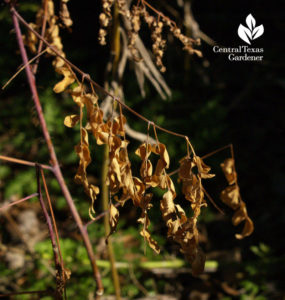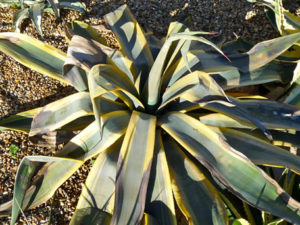How do I winterize my yard?
What do I do to winterize my yard? Preparing your yard for winter in our area (Central Texas) can be a little tricky. Not because it’s difficult, but because we have mild winters. It’s hard to get the timing right when you’re still mowing regularly over the Christmas break. We are often left scratching our heads trying to figure out what needs to happen when.
We don’t have the same winter weather other places deal with. But our yards still experience seasonal changes, and will need special care. For us, winterization isn’t a single event or single service, it’s a list of things that need to be done spread out over the entire season.

OLYMPUS DIGITAL CAMERA
Winter Cut Back
If your plants and shrubs continue to grow into the winter, shrub trimming should continue as well. If you have seasonal and deciduous plants, they typically need to be cut back after they go dormant. Some years, our weather changes gradually, and different plants will go dormant at different times. Other years a cold front will blow through and cause most of the plants to enter dormancy over the space of a few days. Either way, the timing is dictated by our weather, not by a calendar. Keep an eye on the weather report, and then check your yard. With most plants it will be obvious that a cut back is needed. So far this year, most plants have gone dormant, but there are still a few hold outs. We are kind of in a twilight zone at the moment.
In some yards, a rapid shift in temperatures can severely damage some plants. Many people enjoy using true tropical plants in their landscaping, or desert plants that originate in warmer climates. These plants don’t respond well to cold temperatures. Depending on the plant, a freeze warning is also a call to action. If you have potted tropical plants or succulents, they should be brought indoors overnight to avoid damage. Delicate trees like citrus and palm trees can be covered or wrapped to insulate them from the cold. Some of our larger agave are also prone to frost damage, and should be covered as well.
A handy trick to protect these plants is to wrap them with old fashioned incandescent Christmas lights. Incandescent light bulbs use more electricity than newer LED bulbs because some of the electricity is converted into heat. That small amount of heat is often enough to prevent plants from being damaged by freezing weather. This trick is most effective when the plant is also wrapped or covered by burlap or similar covering.
When a plant is damaged in a winter freeze, it is hard to judge how bad the damage is until spring. Some plants, even evergreen plants, can drop their leaves and go dormant as a defensive measure. You often have to wait until spring to see if the plants will leaf out and start growing again.
Fortunately, you won’t have to wait long for the plants to start growing again. We usually start to green up and start transitioning into spring weather around Valentine’s day. At that point, worries about winter and cold fade away, and we can look forward to a long, green growing season.
Mulch
The first thing to be aware of is your mulch. Mulch has multiple benefits for your landscape, but one of the big ones is to help insulate the soil from shifts in weather. Plants store energy and water in their roots. These reserves are what sustain plants through tough weather, and allow the plants to push out new growth come spring. Any damage to the roots has a big impact on how well the plant will do in the coming year. If the damage is severe enough, the plant will die. Mulching your planting beds creates a barrier that protects the roots of your plants. The added insulation will help hold in heat, acting like a natural blanket to keep the soil warm. This is especially important in more exposed areas where wind can cool things off quickly on a cold day.
You don’t necessarily need to add mulch in the winter, just ensure you have a good layer of mulch before the winter starts. 2-3 inches should be enough. If your mulch is thin, or bare soil is exposed make sure you add additional mulch before the cold weather sets in. (Here is another article about mulch that we had printed in the Statesman).
Irrigation
The next thing to be aware of is your irrigation system. Plants still need water over the winter, but the cooler weather reduces their need, and cool temperatures reduces evaporation. The amount of irrigation your yard needs will drop significantly compared to the summer or fall. Start by reducing the amount of water used each time your sprinklers run, and then increase the interval between watering.
Most irrigation controllers have a handy adjustment tool labeled “seasonal adjustment.” It adjusts how long your sprinklers run by a certain percentage. As the weather cools in the fall, you should turn down the seasonal adjustment to compensate. Once winter weather sets in and plant growth slows, reduce your frequency to once every other week or once per month. Each yard is different, so keep an eye on your plants as you adjust your irrigation. If plants look dry, add a watering day or increase your seasonal adjustment a little. Ask us how to winterize your system.
Weeds
 One of the disadvantages to our warmer winters is that we don’t get a break from weeds. As the weather slowly changes, winter weeds like poa, bur clover, and hairy bittercress start to show up. In general, herbicides are less effective in the winter. Read the instructions carefully before applying anything. Many herbicides only work in certain temperature ranges.
One of the disadvantages to our warmer winters is that we don’t get a break from weeds. As the weather slowly changes, winter weeds like poa, bur clover, and hairy bittercress start to show up. In general, herbicides are less effective in the winter. Read the instructions carefully before applying anything. Many herbicides only work in certain temperature ranges.
The best option is to use a pre-emergent herbicide. These try to stop weed seeds from germinating, and the effects generally last for months. There are also organic options available. A late fall application will drastically reduce any winter weeds in your lawn or yard. Homeowners typically have limited access to pre-emergent herbicides, but most professional fertilization companies are more than happy to help out. Pulling winter weeds by hand is always effective as well.
Winter Rye
A favorite option for fighting lawn weeds is to plant winter rye. Over-seeding your lawn with ryegrass keeps your lawn growing all winter long. It is a cool season grass that grows well in our winter weather. The lush, green grass is very good at choking out weeds. It also adds organic material to your lawn, improving soil structure, and helps your lawn hold on to nitrogen, a vital nutrient for grass growth. It is probably a little late to do this now, but think about it for next year.
– plant google
Want to learn a bit more about winterizing your irrigation? Visit this page.
If you want to watch a funny video visit here.

